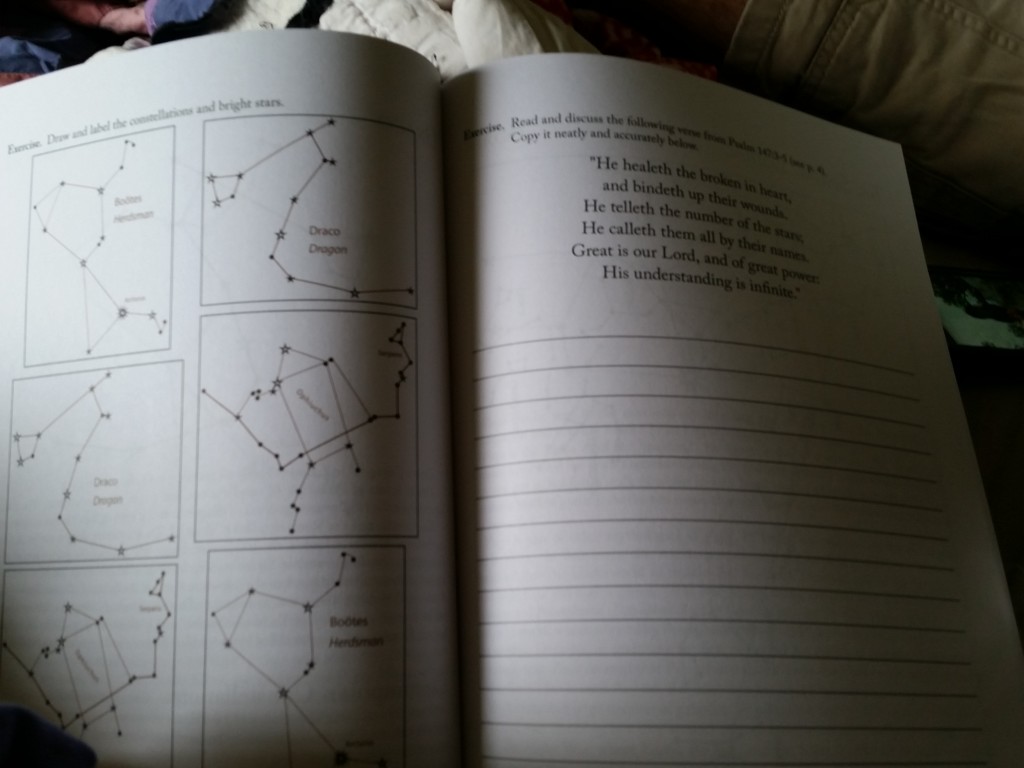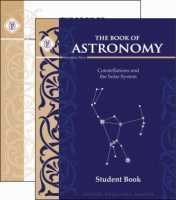Note: Memoria Press sent us their Book of Astronomy Set (including one Student Guide and the Teacher Guide) in exchange for a fair and honest review. The government isn’t happy with my site if I don’t disclose that bit of info. Now we’re all friends again. We also bought D’Aulaire’s Book of Greek Myths with our own money to go along with our study of astronomy. The government doesn’t care about that, but I thought you might.
When we began homeschooling back when our now 19-year-old Hannah was a small fry, we were classical schoolers. That lasted, like, 5 minutes before we learned we were really more the Charlotte Mason type, which lasted several years before we hit the road and became the do-whatever-it-takes-to-not-look-like-a-bunch-of-dumb-hicks-living-in-a-travel-trailer type. We still say we’re Charlotte Mason schoolers, because it sounds better. Point being…
I have a soft spot in my heart for the Classical approach to education. I believe it is effective and it is modeled in Scripture. It also overlaps beautifully with Charlotte Mason, and everything overlaps with the do-whatever-it-takes approach.
Memoria Press is a great classical publisher. Our Latin curriculum is from them, and I, for one, think it’s a hoot! (I know you’re not supposed to have that much fun in Latin, but I can’t help it.) We also reviewed a literature curriculum from them–loved it and are still using it! And now this!
Last things first…
Before I get into the this, that, and the other about The Book of Astronomy, I’m going to go a little backward and give you my final thoughts first.
After this review period has ended, we will continue using this curriculum. That is the ultimate compliment. We will make space for it in our 240 square-foot travel trailer and cart it through the 20-some states we’ll be visiting between now and this time next year. After that, we will reuse it with our younger children.
Not much makes the cut around here. The Book of Astronomy set is a keeper.
Why?
We’re huge into Creation. Studying God’s Creation, particularly the heavens, helps our children grasp that God is so grand that he’s ungraspable, which makes the unbelievable more believable. Did that make sense? If God is so big that he made all that, then he’s big enough to change water into wine and move hearts.
Next, it’s simply fascinating.
Also, it’s impressive when your kids can point to the heavens and bowl a few of the doubting relatives over with some intelligible comments–ha ha ha! Okay, that’s not really the reason, but it is true.
Finally, we’ve seen some amazing night views. Amazing! We love to study them.
Now, let’s hammer out some nuts and bolts.
The teacher’s guide contains the following:
- the cheat version of the student workbook (answers are filled in)
- unit tests
- a final exam
- blackline masters for overhead transparencies…which makes me laugh considering our situation…but for co-ops, that’s brilliant! Actually, I dunno–do people still have overhead projectors? I’m so non-techy!
The student workbook is consumable. If possible, get one for each of your chicos, since they’ll want to practice drawing their constellations.
The study is broken up into units as follows (let’s switch to square bullets this time; they’re fun):
- unit 1: introductory basics, summer-fall constellations, summer-fall zodiac (I’m an aquarius. What are you?)
- unit 2: the winter sky
- unit 3: the spring sky
- unit 4: solar system, planets, munchkin planets, and moons covering the planets, dwarf planets, and major moons.
Each unit also includes exercises, with reviews available at the end of the book as well.

Digging Deeper
If you want to tie science into history and literature, snag the D’Aulaire’s Book of Greek Myths, available at Amazon and similar retailers. The astronomy study references the D’Aulaire book since many of the constellations and stars get their names from the ancient Greeks and Romans. We added it to our library. Our first grader reads it for fun.
Memoria also offers a study guide to go along with the D’Aulaire book, if you really want to dig deep! Neither is necessary for your study of astronomy, but if you’re interested and can swing it, dive in!
The Age Issue
This set is appropriate for grades three and up. Ironically, my first grader is the most interested in it and is diligently memorizing and looking for stars and constellations. She was talking to her sister in college about some of the first magnitude stars, and her sister said, “I didn’t know that. I’m impressed!” She’s hard to impress.
Our main students are the 1st, 4th, and 7th graders, but we also have other ages tagging along. As for the upper age limit, I have learned masses of information. Siriusly. That was a little star joke there.
Additional Thoughts for my Fellow Roadschoolers
If you’re a roadschooler, that means you’ve probably boondocked in Utah or stared at the vast stars in the western skies of Nevada. Stargazing out in the boonies is an experience. Period. This program is worth its minimal size and weight for the educational aspect it will add to your night viewing.
Of course, you’ll need a student book for each student, which takes up a little more space, but they’re slim.
For more reviews, please click here or on the banner below:
Get friendly with Memoria Press on these social sites:




